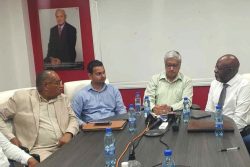Introduction
Production and marketing of Guyana’s abundant oil and natural gas resources provide unheralded opportunities to substantially raise levels of living for its resident population. Transformation of the economy is a critical requirement for the improvements in levels of living to be sustained for current and future generations. Some fundamentals of economic transformation are a massive investment programme in economic and social infrastructure; economic diversification; capacity expansion, cost efficiency, and reliability in the domestic electricity and energy supply sector; and diffusion of economic opportunities. All things considered: Guyana is on the right path to economic transformation.
Economic Diversification
Economic diversification must be manifested in the growth in the contributions of several economic productive sectors to the overall economy. They include agriculture, manufacturing and tourism. Economic diversification must also take place within economic sectors such as agriculture and services.
It is evident that major efforts are being made to strengthen and expand the agriculture and fisheries sub-sectors by investment in capital capacity (equipment and buildings), introduction of new and improved varieties of rice, investments to increase production of a wider range of crops, introduction of new species and improved breeds of animals in the livestock industry, and improvements in irrigation, drainage and flood control infrastructure. Consideration must also be given to the development of the agro-processing industry, other than sugar manufacturing, to ensure that anticipated substantial increases in crop production can be utilised as inputs in manufacturing industry rather than go to waste.
Eco-tourism is being actively promoted regionally and internationally to capitalise on the ecological diversity, wildlife diversity, and the cultural and historical uniqueness of Guyana’s hinterland. The promotional efforts are complemented by capital investments in road and river transportation infrastructure to facilitate movement of people, goods and services for the nascent tourism industry, by financial provisions to expand and improve the quality of accommodation facilities, and by training opportunities to upgrade skills and knowledge in the sector.
Within the services sector, efforts should be made to promote growth in scientific and technical services. Greater focus on science, engineering and mathematics and information technology at secondary and post-secondary levels of the education and training system would help to build the requisite capacity.
Economic and Social Infrastructure Investment
The importance of the massive investment programme currently being undertaken in economic and social infrastructure cannot be overstated as a fundamental component of a holistic programme for Guyana’s economic transformation. The country has major deficits and inadequacies in its transportation infrastructure, water management infrastructure, medical and health infrastructure, and education and training.
Outside of the urban centres, the country is poorly served by the existing networks of land transportation (both road and river). This has handicapped reliable, efficient and affordable delivery of services and goods to rural and hinterland regions and retarded the development and expansion of commercial exports from those regions to the urban centres within Guyana and also to potential international markets. Weaknesses in the transportation network have also resulted in costly impediments to personal travel. Coastal and riverain flooding is a critical problem to be overcome. It severely damages residential and commercial capital in urban areas, rural areas and hinterland districts, and can be demoralising and de-motivating to persons and enterprises adversely affected.
It has been said that the health of a nation is the wealth of the nation. This statement speaks to the effects of good health on the production and productivity of the country’s human resources as well as to the drag remedial health care expenditures would have on personal wealth and national wealth. From these perspectives, investments to improve availability and quality of medical and care facilities on a widespread geographical basis are essential elements in an economic transformation programme for Guyana.
The importance of investments to improve and expand the education and training infrastructure perhaps does not need elaboration in Guyana where for many decades and by most households, education and training have for many decades been recognised as a pathway to personal and national advancement. What needs to be said additionally is that despite this recognition, there are substantial limitations on access because of under-provision of schools in geographically remote areas, income inequalities affecting ability to pay for private education, and transportation and accommodation expenses for post-secondary study in Georgetown and its periphery.
Elements of the education and training infrastructure investment programme are intended to address some of the matters. New facilities are being constructed and some existing ones are undergoing quality enhancement. A significant, innovative element in the education and training infrastructure is the introduction of GOAL, a programme anchored on digital technology, which provides access to a variety of education and skills training opportunities for a substantial proportion of the working age population who had not been beneficiaries of secondary education and post-secondary education and training. Capital investments need to be supported by recurrent expenditures such as grants to households for early childhood, primary and secondary education, and tuition fee subsidies for post-secondary education to surmount the income inequality barrier to access to education and training. Budgetary expenditures of these kinds should be viewed as supplements to investments in education and training by households themselves.
The unreliability and high cost of electricity supply to households and businesses are major impediments to quality of life, productivity and achievement of production targets in all sectors, and delivery of education services. In many remote geographical districts, there is the more extreme problem of no electricity supply. There are several critical components in government investment policies to alleviate these difficulties. Capital investment in the gas-to-shore energy production and distribution facility in Demerara would expand electricity supply on a reliable basis and at affordable rates to consumers. Invest-ments in hydro-electric power elsewhere in the country would do likewise, as would investments in solar energy, especially those targeted to remote population settlements.
Diffusion of Economic Opportunities
The massive scale of the investment programmes for economic and social infrastructure creates opportunities for many existing and potential businesses. There already is expanded demand for construction services and construction materials, and this is certain to grow. While large construction firms will predominate in the implementation of many investment projects, there is scope for the diffusion of economic opportunities in the construction sector. Large construction enterprises often outsource aspects of their contract deliverables to smaller, sometimes specialised, service providers. Many investment projects are also sufficiently small to be in the competitive size and skill range of small companies/operators. There is also scope for small firms to combine or bid jointly for larger projects. All three elements of diffusion of economic opportunities are present in the current infrastructure investment policy framework.
Financing Economic Transformation
The production and marketing of its offshore energy resources enables Guyana to finance its economic transformation at a rate previously unimagined. Revenues derived directly from the oil industry has substantially augmented fiscal resources. Current and projected revenues from the industry have also improved the credit standing and foreign debt capacity of the country, making it possible and affordable to access larger amounts of medium term and long-term loans from official bilateral financial institutions and regional and multilateral financial institution. Frontloading the economic transformation programmes by taking advantage of the sustainable improvements in the country’s international credit standing and debt-bearing capacity makes good economic sense.






